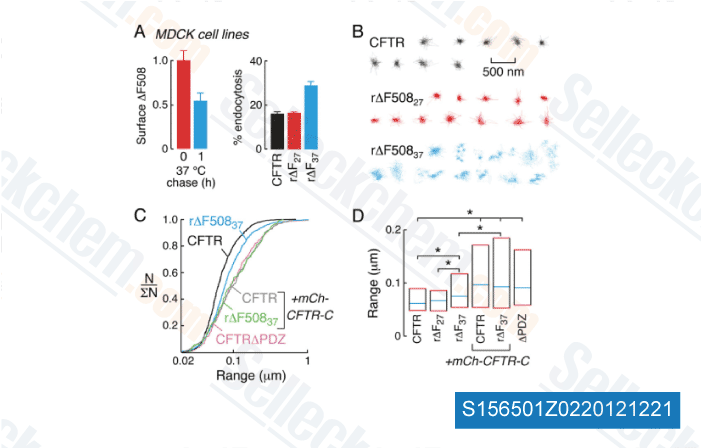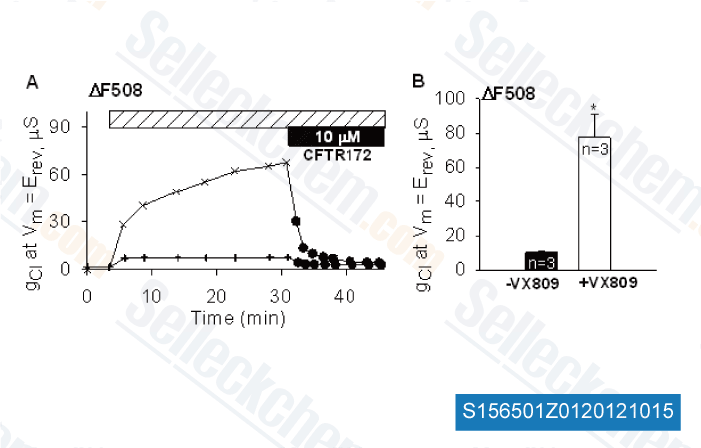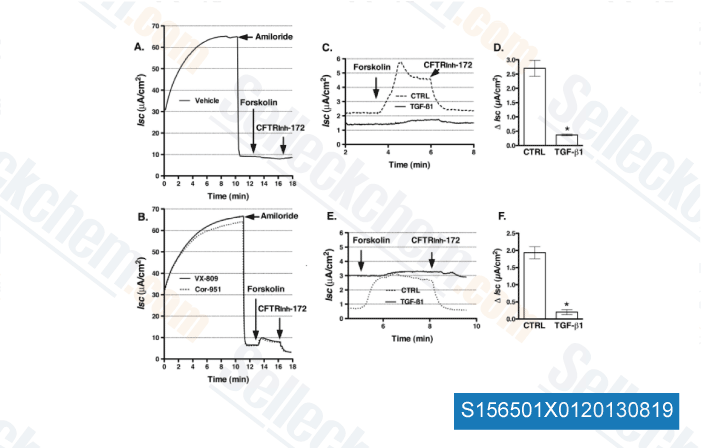|
Toll Free: (877) 796-6397 -- USA and Canada only -- |
Fax: +1-832-582-8590 Orders: +1-832-582-8158 |
Tech Support: +1-832-582-8158 Ext:3 Please provide your Order Number in the email. |
Technical Data
| Formula | C24H18F2N2O5 |
||||||
| Molecular Weight | 452.41 | CAS No. | 936727-05-8 | ||||
| Solubility (25°C)* | In vitro | DMSO | 90 mg/mL (198.93 mM) | ||||
| Ethanol | 4 mg/mL (8.84 mM) | ||||||
| Water | Insoluble | ||||||
| In vivo (Add solvents to the product individually and in order) |
|
||||||
|
* <1 mg/ml means slightly soluble or insoluble. * Please note that Selleck tests the solubility of all compounds in-house, and the actual solubility may differ slightly from published values. This is normal and is due to slight batch-to-batch variations. * Room temperature shipping (Stability testing shows this product can be shipped without any cooling measures.) |
|||||||
Preparing Stock Solutions
Biological Activity
| Description | Lumacaftor (VX-809, VRT 826809) acts to correct CFTR mutations common in cystic fibrosis by increasing mutant CFTR (F508del-CFTR) maturation,EC50 of 0.1 μM in fisher rat thyroid cells. Phase 3. | ||
|---|---|---|---|
| Targets |
|
||
| In vitro | VX-809 acts at the level of the ER to allow a fraction of the F508del-CFTR to adopt a properly folded form, to exit the ER and mobilize to the cell surface for normal functioning. In Fischer rat thyroid (FRT) cells expressing F508del-CFTR, VX-809 treatment significantly improves F508del-CFTR maturation by 7.1 fold with an EC50 of 0.1 μM, and enhances F508del-CFTR-mediated chloride transport by approximately 5 fold with EC50 of 0.5 μM, while VRT-768 has higher EC50 values of 7.9 μM and 16 μM, respectively. In HEK-293 cells expressing F508del-CFTR, VX-809 (3 μM) treatment increases F508del-CFTR exit from the ER by 6 fold, reaching levels comparable to 34% of CFTR. In primary human bronchial epithelial (HBE) cells with F508del-CFTR mutation, VX-809 increases CFTR maturation and enhances chloride secretion with EC50 of 350 nM and 81 nM, respectively, more efficacious than Corr-4a and VRT-325. F508del-CFTR corrected by VX-809 exhibits single-channel open probability of 0.39 similar to normal CFTR of 0.40. Unlike VX-770, VX-809 is not a CFTR potentiator, as acute addition of VX-809 has no effect on F508del-CFTR function. In contrast to VRT-325 and Corr-4a, VX-809 does not improve the processing of the normal or mutant forms of hERG or P-gp, as well as other disease-causing mislocalized proteins, including α1-antitrypsin Z mutant (E342K-α1-AT) or N370S-β-glucosidase, suggesting that VX-809 is specific for CFTR. VX-809 in combination with VRT-325 or Corr-4a has additive effect on CFTR-mediated chloride transport in cultured F508del-HBE. [1] |
||
| In vivo | Lumacaftor (VX-809; VRT 826809) is a CFTR modulator that corrects the folding and trafficking of CFTR protein. |
||
| Features | Higher specificity and efficacy relative to other CFTR defect drugs. |
Protocol (from reference)
| Kinase Assay: |
|
|---|---|
| Cell Assay: |
|
| Animal Study: |
|
References
|
Customer Product Validation

-
Data from [ J Biol Chem , 2012 , 287, 43630-8 ]

-
, , Xuehong Liu of Oregon Health & Science University

-
,

-
Data from [ , , Mol Pharm, 2018, 15(3):759-767 ]
Selleck's Lumacaftor (VX-809) Has Been Cited by 260 Publications
| ACE-tRNAs are a platform technology for suppressing nonsense mutations that cause cystic fibrosis [ Nucleic Acids Res, 2025, 53(13)gkaf675] | PubMed: 40650978 |
| In silico, in vitro and ex vivo characterization of cystic fibrosis transmembrane conductance regulator pathogenic variants localized in the fourth intracellular loop and their rescue by modulators [ Br J Pharmacol, 2025, 10.1111/bph.70176] | PubMed: 40831301 |
| Global functional genomics reveals GRK5 as a cystic fibrosis therapeutic target synergistic with current modulators [ iScience, 2025, 28(3):111942] | PubMed: 40040803 |
| Human Induced Lung Organoids: A Promising Tool for Cystic Fibrosis Drug Screening [ Int J Mol Sci, 2025, 26(2)437] | PubMed: 39859153 |
| Nasal cells as a bronchial cell surrogate for pre-clinical assessment of drug response in cystic fibrosis [ Front Pharmacol, 2025, 16:1651122] | PubMed: 40978488 |
| Inhibitors of the ubiquitin‑proteasome system rescue cellular levels and ion transport function of pathogenic pendrin (SLC26A4) protein variants [ Int J Mol Med, 2025, 55(5)69] | PubMed: 40052591 |
| The Inhibition of the Membrane-Bound Transcription Factor Site-1 Protease (MBTP1) Alleviates the p.Phe508del-Cystic Fibrosis Transmembrane Conductance Regulator (CFTR) Defects in Cystic Fibrosis Cells [ Cells, 2024, 13(2)185] | PubMed: 38247876 |
| Comprehensive Assessment of CFTR Modulators' Therapeutic Efficiency for N1303K Variant [ Int J Mol Sci, 2024, 25(5)2770] | PubMed: 38474016 |
| Estimation of Chloride Channel Residual Function and Assessment of Targeted Drugs Efficiency in the Presence of a Complex Allele [L467F;F508del] in the CFTR Gene [ Int J Mol Sci, 2024, 25(19)10424] | PubMed: 39408749 |
| The F508del-CFTR trafficking correctors elexacaftor and tezacaftor are CFTR-independent Ca2+-mobilizing agonists normalizing abnormal Ca2+ levels in human airway epithelial cells [ Respir Res, 2024, 25(1):436] | PubMed: 39702307 |
RETURN POLICY
Selleck Chemical’s Unconditional Return Policy ensures a smooth online shopping experience for our customers. If you are in any way unsatisfied with your purchase, you may return any item(s) within 7 days of receiving it. In the event of product quality issues, either protocol related or product related problems, you may return any item(s) within 365 days from the original purchase date. Please follow the instructions below when returning products.
SHIPPING AND STORAGE
Selleck products are transported at room temperature. If you receive the product at room temperature, please rest assured, the Selleck Quality Inspection Department has conducted experiments to verify that the normal temperature placement of one month will not affect the biological activity of powder products. After collecting, please store the product according to the requirements described in the datasheet. Most Selleck products are stable under the recommended conditions.
NOT FOR HUMAN, VETERINARY DIAGNOSTIC OR THERAPEUTIC USE.
